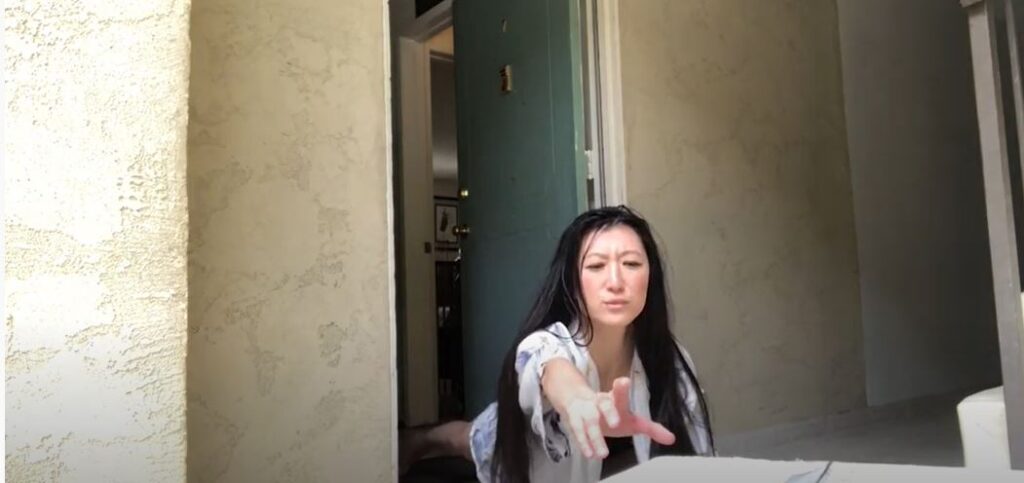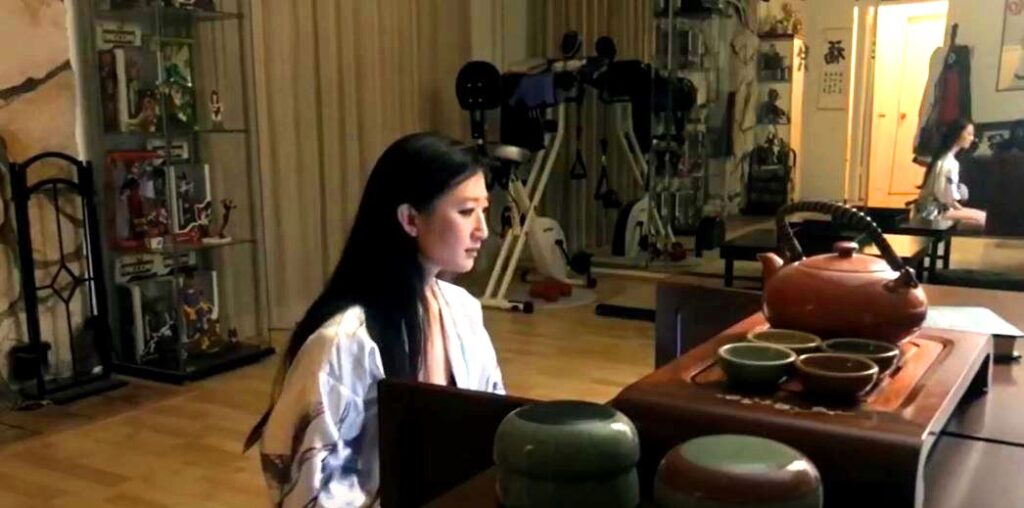How Jennifer Zhang Made ‘Charon,’ the First Horror Feature Edited on a Smartphone App

Charon, Jennifer Zhang’s new film that’s swept through the festival circuit, isn’t just getting praise for its story. It’s also turning heads for being filmed on an iPhone—and for becoming the first feature ever to be edited entirely on a smartphone app.
Written and directed by Zhang, Charon is a psychological horror about isolation and the effects it has on one’s mental stability. Following its stop at Horrible Imaginings Film Festival, Dread Central asked Zhang, who also stars as the titular protagonist, to share her story about making a horror feature using only her smartphone… and the meta experience of making a film about isolation while in isolation. —C.G.
As told to Chloé Gold

I’m going to tell you something that I’ve never told anybody. It’s deeply personal, but since Charon just finished its last festival appearance, I might as well litter the landscape with drama…
At the very start of the pandemic, I knew I wanted to do a project—and I was also romantically involved with somebody. The start of any relationship is kind of the “do or die” moment, where it’s so new that you have to make a decision on whether or not you’re going to get more serious.
But it was a non-starter.
I felt like I was trapped in my apartment and I didn’t know him well. I felt like I was constantly waiting for him to call, or for him to do something, and like I had no control over my outside environment. I didn’t know anything about him.
Also Read: Horrible Imaginings Review — Charon Is a Brutal Exploration of Isolation and Betrayal
I started thinking, “If he’s just, like, a sociopath… I would have no way of knowing!” Then I started thinking, “Why does he disappear for such long periods of time?” And then I started thinking, “What if he is a sociopath? What if he’s a psychopath?”
The plot of Charon was born out of that: How well do you know somebody when you have limited access to them?
The conditions of the pandemic made it so that my creative juices were contained. I had a project that was supposed to go and was suddenly put on hold because of the state of the world. So, I just put all of my energy into doing what I do, which is to make a damn film!
Going a Little Mad
During the pandemic, a lot of us were tearing ourselves apart. When you have nothing to do, your mental health hangs by a thread.
In the movie, the only thing that keeps my character, Charon, sane on a daily basis is the fact that she has this set routine: “If I do this, then I can get to the next thing.” Her routine always culminates in a nightly conversation with her boyfriend, Jerry (Eric Radic), the one person that she cares about. But because it’s all so fragile, any disruption to that routine makes her world fall apart. And when things get really unpredictable, she’s trapped in her own Hell.
That’s an experience many of us subjected to at the start of the pandemic. All of our extroverted friends were suddenly in their own prisons. A lot of my friends had mental breakdowns. I’m sure we all did.
As I made this film, it was as if I was living a parallel existence to Charon. Because the character has her own daily regiment, I would often just film the routine that I myself was actually going through.

The “meta” part of this is that I became fixated on making sure that every day was devoted to this movie, from waking up, to setting up the shots, to making the shot list. And no one was holding me to that schedule but myself.
This all became an obsession. It’s easy to get into that state when you’re in isolation… you go a little bit mad. The production took on a life of its own. I would shoot all day, then lie in bed, go over the dailies on my phone, edit it on my phone, and assemble the scenes from the day as an assembly cut.
That was the process, on loop, every single day. I started losing a lot of weight, because finishing this project was so paramount for me that I would forget to take care of myself. In the movie, Charon starts to become kind of gaunt—but that’s not makeup. That’s me forgetting to eat for two months. And since I shot a lot of the movie sequentially, it worked.
Making History… By Accident
I wish I were a genius for shooting and editing Charon on a smartphone. (Maybe I should just say that I was.) But the decision to do that came when, at the start of the pandemic, all of the rental houses closed, so you couldn’t take out equipment.
I didn’t have any crew near home, and obviously I couldn’t have anyone in my apartment. So, the mental exercise became, “How can I make this movie with what I have?” And the natural follow-up to that question was, “Would this movie look good enough on a phone?”
The whole thing was an experiment and a challenge. Nothing was at stake and I didn’t have anyone to answer to, so I don’t think I would have abandoned it even if it did look bad. But I was surprised when, on day one, everything started looking really good. The big thing I learned is that if you have a vision and you have some practice and experience making a film, that’s all that matters. Your tools are what they are, and fortunately, the tools that are available now are pretty good.

I’m tickled that people like the idea that Charon was shot on a phone, but the process of editing on an app was what surprised even me. Again, I did it out of necessity, but I was shocked that editing apps are good enough for a filmmaker to use. The app I used is called VideoShop, and it was made specifically to make social media videos. Even the developer of the app, who I got in touch with, didn’t know it was possible to edit an entire feature with it.
I edited every individual scene as its own short film, labeled them carefully, and then strung them all together on a timeline. It turns out that nobody’s ever done this before, ever. When Susy Botello, the founder of the International Mobile Film Festival—where Charon won Best Feature—spoke with the smartphone cinema community, she discovered that no one had ever edited an entire movie on a phone before.
This is one of those situations where I want to claim that I was an avant-garde pioneer… but really, it was just by accident.
The Horror of Charon
Charon also screened at the London International Smartphone Festival, the Alternative Film Festival, Frostbite, Indie Fest, International Independent Film Awards, and Jelly Fest. To be honest, I saw it as a drama—never as a horror film.
It was executive director Miguel Rodriguez at Horrible Imaginings Film Festival who convinced me it had horror undertones. I had no conception of how it fit into the genre, but I’m glad he got me to see it his way.

I knew from the start that I wanted my character’s name to be the title of the movie, and I knew that I wanted the name to conjure up images of death. As morbid as that sounds, a core theme of the movie is: Is the life that Charon’s living really living?
I don’t think it is. Her life is a kind of purgatory. It’s not that Charon is literally in purgatory, or that Jerry is a resident of Hell. But Jerry is on this fixed path, doing this thing every day, so his character represents the idea that Charon is not living a real life.
Headstrong Stunt Work
Once I cast Eric, who’s a friend of mine, he and I shared our scenes entirely over Skype. Only one person—our stunt coordinator, Marc Morrisseau—ended up working with me in my physical space.
Marc had just become a father and I knew that he had been completely isolated and was not in danger of contracting COVID, so our shooting environment was safe. Plus, his role required him to wear a mask, so it worked out perfectly. Marc’s been my main stunt coordinator on various projects for well over a decade. So, I called him up and asked, “Hey, want to come over and kick my ass?,” and he said, “Oh, sure, what else is new?”
During the shoot I was badly injured, and it was completely my fault.
In one scene, my character’s head gets slammed into a wall. The way that stunt is done correctly is that Marc would have my hair in his hand while he’s wearing a glove, and I’m supposed to slam my head back so that his hand gets all the impact.
However, because my hair is so glossy, Marc’s hand slipped—and I was so in the moment that I didn’t feel it. I slammed my head hard against the wall and concussed myself pretty badly. The good thing is the shot looks great, and that’s what made it into the movie! But I was dizzy for about three days after that. I probably should have gone to a hospital… but you know how hospitals were at the time.
Art For Art’s Sake
I’m primarily a producer-writer, so I’m constantly splitting my mind when it comes to the business side of filmmaking, thinking about what’s marketable and how I can attract investment. But none of that came into play when I made Charon. This film was art for art’s sake.
At first, I was just going to put Charon on YouTube. I didn’t intend to run it through any festival. But then my manager watched it, wagged his finger, and said, “What are you doing?” I had poured a lot of love into the film, but in my head it wasn’t a “real movie.” Now, ironically, it’s gotten more festival attention, won more awards, and arguably has more buzz than the first movie I made on a real budget.
My hope is that if Charon resonates with people, it’ll be because of the conditions in which it was made and its subject matter. Lightning in a bottle, right? Oh, and I did gain all that weight back in a week. I just DoorDashed myself some donuts.
Charon had its last festival screening at Horrible Imaginings Film Festival 2021. Avatar Entertainment has foreign sales rights to the film.
Categorized: Editorials News
